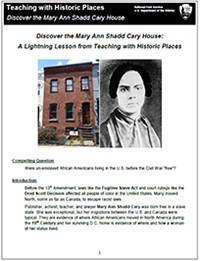
(NPS Photo of MASC House; CA Archives photo of MASC)
Contents
| Introduction
| Materials in the Lesson (Maps, Readings, Visual Evidence)
| Post-Lesson Activities
| Where it Fits Into the Curriculum (Objectives and Standards)
| More Resources
| About
Were free African Americans, living in the United States before the Civil War, truly “free”?
Before the 13th Amendment, laws like the Fugitive Slave Act and court rulings like the Dred Scott Decision affected all people of color in the United States. Many moved North, some as far as Canada, to escape racist laws.
Publisher, activist, teacher, and lawyer Mary Ann Shadd Cary was born free in a slave state. She was exceptional, but her migrations between the U.S. and Canada were typical. They are evidence of where African Americans moved in North America during the 19th Century and her surviving D.C. home is evidence of where and how a woman of her status lived.
Materials Found in the Full Lesson
Accompanying Question Sets are paired with all materials in the Full Lesson (PDF).
Map 1: The U.S. in 1860, showing free and slave regions, and Mary Ann Shadd Cary’s movements from her birth in Delaware to her death in D.C.
• Text: Primary and secondary source readings provide content and spark critical analysis.
Reading 1: The Life of Mary Ann Shadd Cary, by Maria L. Strohmayer and Katie Orr
Reading 2: “Mecca of the Colored Pilgrim,” quotation by Mary Ann Shadd Cary.
Photo 1: Former Home of Mary Ann Shadd Cary, Washington, D.C., July 2016.
• Activity 1: From Paper to the Podium: Persuasive Writing and Speaking
• Activity 2: Nineteenth Century Urban Engineering and Home Comforts
• Activity 3: Preserving History in your Local Community
Where it Fits into the Curriculum
This lesson can be used in history and social studies curricula to learn about African American and women’s experiences in the United States.
Time Period: Middle to late 19th century, Antebellum Era, Reconstruction Era.
Objectives
1. Explain connections between African American migration patterns in the 1800s and events including the passing of the Fugitive Slave Act, Dredd Scott decision, and Reconstruction ;
2. Describe Mary Ann Shadd Cary’s accomplishments and the cultural barriers she broke;
3. Write a persuasive speech OR Reproduce 19th century domestic technology in an art project OR Propose a solution to a local historic preservation controversy or challenge.
National Standards for History, Social Studies, and Common Core
• Standard 4A: The student understands the abolitionist movement
• Standard 4C: The student understands changing gender roles and the ideas and activities of women reformers
This lesson relates to Thematic Strands from the National Council for the Social Studies' National Standards:
• Theme II: Time, Continuity, and Change
• Theme III: People, Places, and Environments
• Theme IV: Individual Development and Identity
• Theme VI: Power, Authority, and Governance
• Theme IX: Global Connections
• Theme X: Civic Ideals and Practices
This lesson relates to the Common Core Standards in History/Social Studies (6-8, 9-10, 10-11):
• CCSS.ELA-Literacy.RH.6-12.1
• CCSS.ELA-Literacy.RH.6-12.2
Craft and Structure
• CCSS.ELA-Literacy.RH.6-12.4
• CCSS.ELA-Literacy.RH.6-12.5
Integration of Knowledge and Ideas
• CCSS.ELA-Literacy.RH.6-12.7
• CCSS.ELA-Literacy.RH.6-12.9
Range of Reading and Level of Text Complexity
• CSS.ELA-Literacy.RH.6-12.10
See the Full Lesson (PDF) for details about how the these Standards and Themes relate to the lesson. Search our Lesson Plans by National History Standards or Lesson Plans by Social Studies Standards to identify lessons that correspond with the eras and themes you want to teach.
The National Park Service features historic places along the Underground Railroad on this online travel itinerary. Learn more about the Underground Railroad by exploring photos and multimedia at one the National Park’s newest national parks: The Harriet Tubman Underground Railroad National Historical Park in Maryland.
District of Columbia Office of Planning
Washington D.C.’s State Historic Preservation Office provides information about city history and documentation about historic places in the city, including the U Street District.
Heritage Minutes
Heritage Minutes produced audio recordings based on written communications between Mary Ann Shadd Cary and Henry Bibb, a leading African-American figure in Canada during the Civil War. They discuss their differing points of view on how black communities should be organized.
ActiveHistory.ca
ActiveHistory.ca produced an educational film on “Mary Ann Shadd Revisited: Echoes From an Old House”. Available on YouTube, the film documents the discovery of Shadd Cary’s personal letters in 1974 after the demolition of her former home in Canada.
The National Geographic
National Geographic offers an interactive 3-D online game where players act as freedom seekers escaping bondage. The game includes a classroom educator’s guide. National Geographic also features an online interactive activity on “How Slaves Found Their Way North”.
The Schomberg Center For Research in Black Culture
The Schomberg Center for Research in Black Culture highlights “The Northern Migration: 1840s to 1890s” under its project, “In Motion: The African-American Migration Experience”. The online exhibit offers a historical overview, an image gallery, maps, and population charts related to the migration of free blacks from the South to the North.
Library of Congress
The John W. Kluge Center at the Library of Congress shares an interview on their blog with historian Kate Masur. Masur offers insight on the changes in Washington, DC during the Civil War and Reconstruction Era, especially in terms of living conditions of African Americans.
This lesson is based on the National Register of Historic Places nominations for the Greater U Street Historic District (with photos) and the Mary Ann Shadd Cary House (with photos). Discover the Mary Ann Shadd Cary House: A Lightning Lesson from Teaching with Historic Places was published in 2016. This lesson was written by National Park Service Historians, Katie Orr and Jenny Masur, and by Maria Lee, an independent Historical Anthropologist. It was edited by the Cultural Resources Office of Interpretation and Education staff in Washington, D.C. This lesson is one in a series that brings the important stories of historic places into classrooms across the country.
Last updated: September 26, 2024


